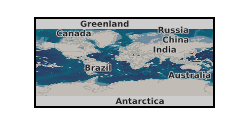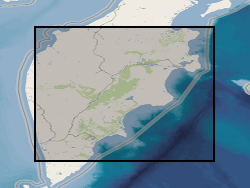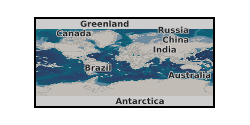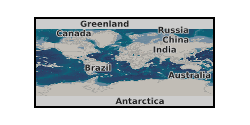Melts
Type of resources
Topics
Keywords
Contact for the resource
Provided by
Years
Formats
Representation types
Update frequencies
-

This dataset comprises broadband seismic data from the Askja Caldera, Iceland, which consists of ~12 months of continuous recording from August 2023-August 2024. A total of 23 Guralp 6TD and Certimus seismometers were deployed in and around the ~8km diameter caldera, with sampling rates set to 100sps. Each seismometer was buried ~30cm below the surface, and attached to a power supply consisting of 3 100Amp-hour batteries and 100 W solar panels mounted on a wooden frame. The batteries were placed in a box that sat on the supports of the solar panel frame to act as ballast, and wrapped in a plastic sheet. A Gps unit was mounted on the solar panel frame. Access to most stations is by foot, and installation was undertaken either by carrying the equipment on foot or by helicopter. The dataset provided is in standard miniseed format, and has an accompanying dataless file for each instrument type in xml format. The miniseed data is archived in day files under the directories "2023" and "2024", while the xml file is located in the directory "dataless". The data is of good quality, with both local earthquakes and teleseisms easily detected. The data were collected for the purposes of tracking microseismic activity associated with the recent reinflation event at Aska, and to help facilitate seismic imaging beneath the caldera using both body and surface wave tomography. The data may be of use to other scientists with an interest in earthquake seismology, imaging, and characterisation of geothermal areas near active volcanoes. The data were collected by the University of Iceland and University of Cambridge, both of who are responsible for interpretation of the data. The archive is complete as it currently stands. The data were converted into miniseed using a standard format that is consistent with archives stored at the IRIS DMC.
-

This dataset comprises seismic node data from the Askja Caldera, Iceland, which consists of one month of continuous recording in each of July/August 2023 and July/August 2024. A total of 14 nodes were deployed within the ~8km diameter caldera; each unit consists of a 3-component Smartsolo sensor (IGU-16HR 3C) recording at 250sps. The units were buried such that their tops were ~10cm below the surface. The nodes were distributed irregularly in the caldera due to access issues; namely, only portions of the caldera are walkable. The dataset provided is in standard miniseed format, and has accompanying dataless files in xml format. The miniseed data is archived in day files under the directories "2023" and "2024", while the xml files are located in the root directory of the distribution. The data is of good quality, with both local earthquakes and teleseisms easily detected. The data were collected for the purposes of tracking microseismic activity associated with the recent reinflation event at Aska, and to help facilitate seismic imaging beneath the caldera using both body and surface wave tomography. The data may be of use to other scientists with an interest in earthquake seismology, imaging, and characterisation of geothermal areas near active volcanoes. The data were collected by the University of Iceland and University of Cambridge, both of who are responsible for interpretation of the data. The archive is complete as it currently stands.
-

Water concentration as a function of position in silicates from diffusion couple experiments. Data can be used to determine diffusivity of water in the silicate melt. Also numerical model for analysis of dataset and associated user guide.
-

Data shows the composition (in wt. %) and the modelled temperature-viscosity relationship (800-1600 degrees) for various generic compositions of magmas and variable water contents. These data are used for the viscosity curves shown in figure 11 of Kendrick and Lavallée, 2022 (https://doi.org/10.2138/rmg.2022.87.20). The data involve only idealised compositions, not real samples, and the data was compiled at the University of Liverpool, UK. These data were compiled in 2021. The generic magma compositions were input into the open access Viscosity calculator "GRD", available at; https://www.eoas.ubc.ca/~krussell/VISCOSITY/grdViscosity.html and the resulting temperature-viscosity relationship for each generic composition was generated, providing the lines used in Fig. 11 of the review paper Kendrick and Lavallée, 2022. These data help understanding the viscosity-temperature relationship of different composition magmas with different dissolved water content.
-

Laser ablation (LA) ICP-MS analyses of olivine-hosted melt inclusions from Fuego volcano, Guatemala eruptions on the 14th, 17th and 23rd October, 1974. Full descriptions regarding the analysed samples are given in Rose et al. (1978) and Lloyd et al. (2013). References Lloyd, A.S., Plank, T., Ruprecht, P., Hauri, E.H. and Rose, W. (2013) Volatile loss from melt inclusions in pyroclasts of differing sizes. Contributions to Mineralogy and Petrology 165, 129-153. Rose, W.I., Anderson, A.T., Woodruff, L.G. and Bonis, S.B. (1978) The October 1974 basaltic tephra from Fuego volcano: Description and history of the magma body. Journal of Volcanology and Geothermal Research 4, 3-53.
-

This dataset contains bulk rock, glass, melt inclusion and host phenocryst geochemical compositions for materials from Tolbachik volcanic field, Kamchatka, Russia, together with supporting petrographic information. Sampling localities are provided together with the bulk rock compositional data. Samples were acquired between 2016 and 2019 and the data were collected between 2016 and 2020 using secondary electron microscopy, electron microprobe analysis, secondary ion mass spectrometry, laser ablation ICP-MS, X-ray fluorescence and solution ICP-MS, and multi-collector ICP-MS methods. Most of the data are included in a manuscript (Iveson et al.) to be submitted to Journal of Petrology in March 2022.
-

Ab initio trajectories for the equilibrated MgO-SiO2-H2O melts at T = 1800 K and 3000 K are provided as "XDATCAR" files output directly from VASP for each simulation interval. Corresponding stress tensor components, required for calculation of viscosity via the autocorrelation function, together with the energy, temperature, and pressure are also provided for each iteration of the equilibrated trajectories. A full data inventory is provided in the READ_ME.txt file.
-

Major and trace element data for partial melts derived from high pressure-temperature experiments on a basaltic starting composition from the Ontong Java Oceanic Plateau.
 NERC Data Catalogue Service
NERC Data Catalogue Service